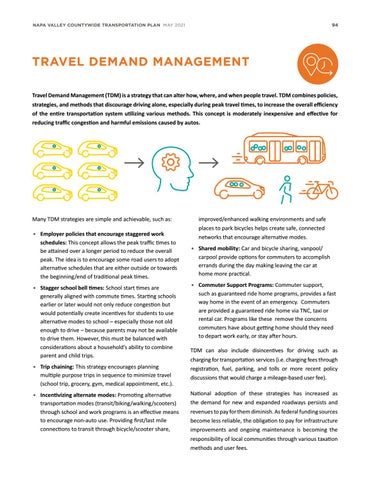94
NAPA VALLEY COUNTYWIDE TRANSPORTATION PLAN MAY 2021
TRAVEL DEMAND MANAGEMENT Travel Demand Management (TDM) is a strategy that can alter how, where, and when people travel. TDM combines policies, strategies, and methods that discourage driving alone, especially during peak travel times, to increase the overall efficiency of the entire transportation system utilizing various methods. This concept is moderately inexpensive and effective for reducing traffic congestion and harmful emissions caused by autos.
Many TDM strategies are simple and achievable, such as: y
y
Employer policies that encourage staggered work schedules: This concept allows the peak traffic times to be attained over a longer period to reduce the overall peak. The idea is to encourage some road users to adopt alternative schedules that are either outside or towards the beginning/end of traditional peak times. Stagger school bell times: School start times are generally aligned with commute times. Starting schools earlier or later would not only reduce congestion but would potentially create incentives for students to use alternative modes to school – especially those not old enough to drive – because parents may not be available to drive them. However, this must be balanced with considerations about a household’s ability to combine parent and child trips.
y
Trip chaining: This strategy encourages planning multiple purpose trips in sequence to minimize travel (school trip, grocery, gym, medical appointment, etc.).
y
Incentivizing alternate modes: Promoting alternative transportation modes (transit/biking/walking/scooters) through school and work programs is an effective means to encourage non-auto use. Providing first/last mile connections to transit through bicycle/scooter share,
improved/enhanced walking environments and safe places to park bicycles helps create safe, connected networks that encourage alternative modes. y
Shared mobility: Car and bicycle sharing, vanpool/ carpool provide options for commuters to accomplish errands during the day making leaving the car at home more practical.
y
Commuter Support Programs: Commuter support, such as guaranteed ride home programs, provides a fast way home in the event of an emergency. Commuters are provided a guaranteed ride home via TNC, taxi or rental car. Programs like these remove the concerns commuters have about getting home should they need to depart work early, or stay after hours.
TDM can also include disincentives for driving such as charging for transportation services (i.e. charging fees through registration, fuel, parking, and tolls or more recent policy discussions that would charge a mileage-based user fee). National adoption of these strategies has increased as the demand for new and expanded roadways persists and revenues to pay for them diminish. As federal funding sources become less reliable, the obligation to pay for infrastructure improvements and ongoing maintenance is becoming the responsibility of local communities through various taxation methods and user fees.







